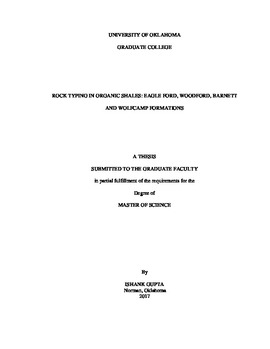| dc.description.abstract | Shales are the most common sedimentary rocks found on earth. Most US shale plays are spatially extensive with regions of different maturity and varying prospects. With increasing understanding of the heterogeneity, microstructure and anisotropy of shales, efforts are now directed to identifying sweet spots and optimizing completion zones in any shale play. Rock typing is a step in this direction. It is becoming an integral part of the unconventional reservoir characterization workflow.
In this work, an integrated workflow is presented for rock typing using lab petrophysical measurements, logs, and production data. The key petrophysical parameters used for rock typing are porosity, total organic carbon (TOC), mineralogical compositions and mercury injection capillary pressure (MICP). Principal Component Analysis (PCA) is used to reduce dimensionality of the dataset and improve efficiency of the clustering algorithms. Unsupervised clustering algorithms like K-Means and Self Organizing Maps (SOM) are used to define rock types. The integrated workflow is applied separately for four shale plays namely Barnett, Eagle Ford, Woodford and Wolfcamp.
A total of 25 wells with core data are considered for rock typing in the four shale plays. The rock types are upscaled to more than 140 wells representing a 20,000-ft. depth interval. A manual approach would have been prohibitively time-consuming.
Rock Type 1 is generally characterized by high porosity, high TOC, and high brittleness. Not surprisingly, Rock Type 1 has the highest positive impact on well productivity. Rock Type 2 has intermediate values of porosity and TOC and thus, moderate source potential and storage. Rock Type 3 has the highest carbonate content (except Eagle Ford) and poor storage (except Eagle Ford) and source rock potential.
Classification algorithms like Support Vector Machines (SVM) are used to upscale rock types from core data to logs. The training datasets comprise of depths at which both core and log data are available. Different logs like gamma ray, resistivity, neutron porosity and density are used for upscaling. Finally, a rock type ratio (RTR) is defined based on the fraction of Rock Type 1 over gross thickness. RTR is found to strongly correlate with normalized oil equivalent production rate.
The study is unique as it integrates core, log, and production data to identify different rock types. Multiple algorithms are used and the similarity of results between their outputs further bolstered the confidence in the derived rock types. The rock type logs can aid the reservoir or production engineer in optimizing perforation intervals and number of fracture stages. Rock Type 3 is poor reservoir and may not warrant any perforation or fracturing. On the other hand, Rock Type 1 can be selectively perforated and fractured to save cost and maximize production from a well. Other applications of rock typing are 3D reservoir modeling, identifying sweet spots in combination with seismic attributes, new well locations, improved volumetric estimates and uncertainty and risk analysis. | en_US |
| dc.subject | Data Mining, Rock Typing, Eagle Ford, Wolfcamp, Woodford, Barnett, SVM, K-means, Core to log | en_US |
